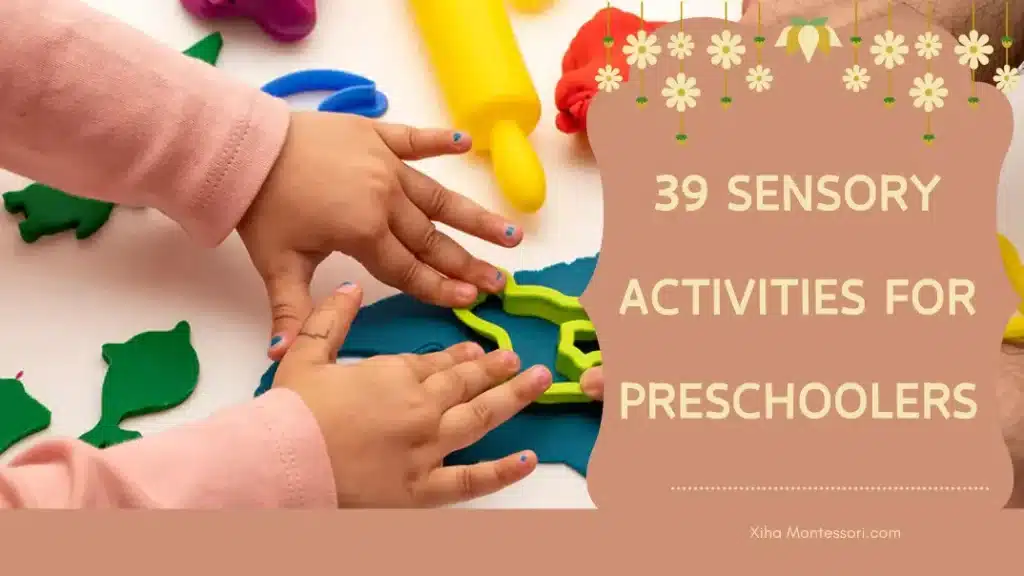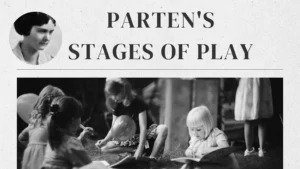Educators and parents often wonder how to create fun environments for preschoolers. Sensory activities for preschoolers provide an effective solution. It engages children’s senses, promotes learning through exploration, and lays the foundation for their overall development.
This article explores 39 optimal sensory activities designed specifically for preschoolers, ensuring that learning through play is effective and enjoyable.
What is Sensory Play?
Sensory play activities for preschoolers are any activity that engages one or more of a child’s senses: sight, sound, touch, taste, and smell. These activities range from simple experiences like texturing exploration to more complex tasks involving multiple senses. Sensory play is foundational in early childhood development, as it allows children to learn about their environment, experiment with learning materials, and express their creativity.
Why are Sensory Activities Important for Preschoolers?
Sensory activities offer many benefits that significantly contribute to a child’s development. Here are a few critical reasons why they are essential:
Develop Motor Skills
Sensory activities for preschoolers often require physical interaction, which helps improve fine and gross motor skills. Pouring, scooping, and molding materials encourage hand-eye coordination and dexterity.
Improve Social Skills
When children engage in sensory play activities for preschoolers together, they learn to communicate, share, and collaborate. This group interaction fosters social development and helps them build friendships.
Language Development
Sensory activities for preschoolers offer rich opportunities for vocabulary building. As children explore different materials, caregivers can introduce new words related to textures, colors, and actions, enhancing their language skills.
Build Neural Connections
Engaging in diverse sensory activities for preschoolers helps strengthen neural pathways in the brain. This foundational development is crucial for cognitive growth and later learning.
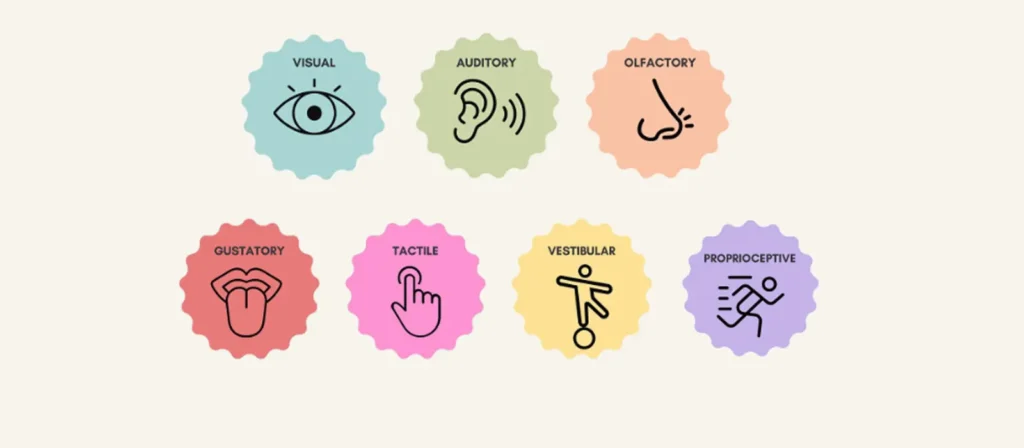
Types of Sensory Play
Understanding the different types of sensory play can help provide preschoolers with varied experiences. Here are several categories:
- Visual Sensory Play: Visual sensory play engages a child’s sense of sight. Activities like color sorting or using light tables enhance visual discrimination and creativity.
- Auditory Sensory Play: Auditory sensory play involves sound and music. Creating musical instruments or listening to different sounds promotes auditory awareness and memory.
- Olfactory Sensory Play: Olfactory sensory play stimulates the sense of smell. Activities like scent jars or cooking allow children to explore different aromas and learn to differentiate between them.
- Tactile Sensory Play: Tactile sensory play focuses on the sense of touch. Activities like exploring various textures (e.g., sand, water, or fabric) enhance fine motor skills and sensory discrimination.
- Taste Sensory Play: Taste sensory play allows children to explore flavors. Cooking activities or tasting different fruits can expand their palate and encourage healthy eating habits.
- Vestibular Sensory Play: Vestibular sensory play involves movement and balance. Activities like swinging or spinning enhance balance and coordination while providing sensory input.
- Proprioceptive Sensory Play: Proprioceptive sensory play engages body awareness and spatial orientation. Jumping or climbing helps children understand their body’s position and movement.
Sensory activities are designed to stimulate one or more of the five senses: sight, sound, touch, taste and smell. These activities are vital for preschoolers because they help develop their sensory processing skills. Children learn about the world around them through their senses, making sensory play a key aspect of their development.

Sensory Play Ideas for Different Ages
Sensory Play for Babies (0 to 12 Months)
- Tummy Time with Textured Mats: Use mats with different textures for babies to explore during tummy time. This activity helps develop their muscles and coordination.
- Water Play: Fill a shallow tub with water and safe floating toys. Allow babies to splash and feel the water.
- Scent Exploration: Introduce soft fabrics with various scents (like lavender or vanilla) for babies to explore during cuddling.
Sensory Play for Toddlers (1 to 3 Years)
- Play-Dough Exploration: Provide play dough with tools for rolling and cutting. This enhances fine motor skills and creativity.
- Nature Sensory Bins: Fill a bin with leaves, pinecones, and flowers. Encourage toddlers to explore different textures and smells.
- Sand Play: Set up a sandbox where toddlers can dig, pour, and create, improving hand-eye coordination.
Sensory Play for Older Children (3 Years and Up)
- Science Sensory Activities for Preschoolers: Engage children with simple experiments like mixing baking soda and vinegar to explore reactions.
- Art Projects: Use various textures in art, like gluing sand or fabric onto paper, to create sensory-rich artwork.
- Outdoor Exploration: Organize scavenger hunts where children find items with different textures, colors, and smells.
39 Sensory Activities for Preschoolers
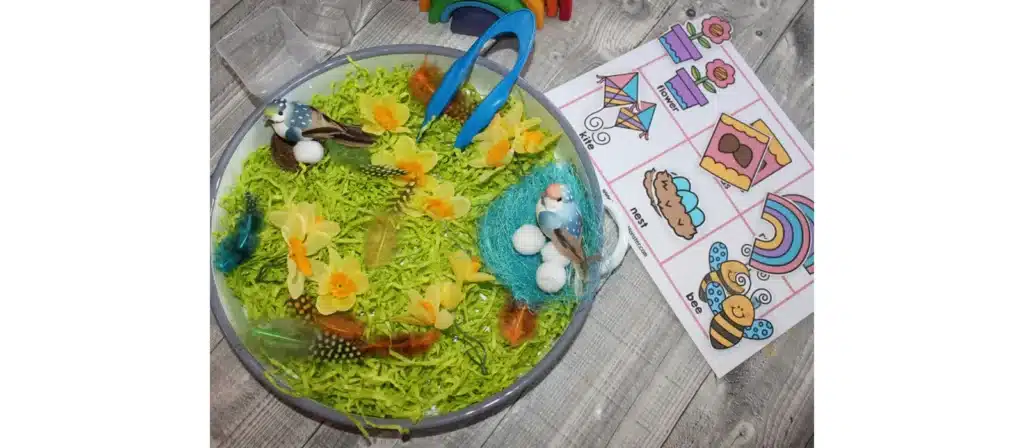
Spring Sensory Activities for Preschoolers
1. Flower Garden Sensory Bin
Create a vibrant sensory bin filled with soil, plastic flowers, and gardening tools. This activity allows children to dig, plant, and nurture their mini-garden, promoting tactile exploration and imaginative play.
- Materials: Soil, plastic flowers, small pots, and gardening tools.
- Setup: Fill a large bin with soil, insert the plastic flowers, and provide tools for digging and planting.
2. Nature Scavenger Hunt
Organize a nature scavenger hunt where children collect leaves, flowers, and rocks. This activity encourages outdoor exploration and discussion about different textures and colors found in nature.
- Materials: Scavenger hunt list and bags for collecting items.
- Setup: Provide each child with a list of items to find and bags to collect, guiding them through a park or garden.
3. Rainbow Rice Sensory Bin
Dye rice in various colors to create a rainbow sensory bin. Children can explore the rice using cups, scoops, and toys, enhancing their sensory processing skills through tactile play.
- Materials: Rice, food coloring, containers, scoops.
- Setup: Mix rice with food coloring in separate bags to create vibrant colors, then fill a bin with the dyed rice.
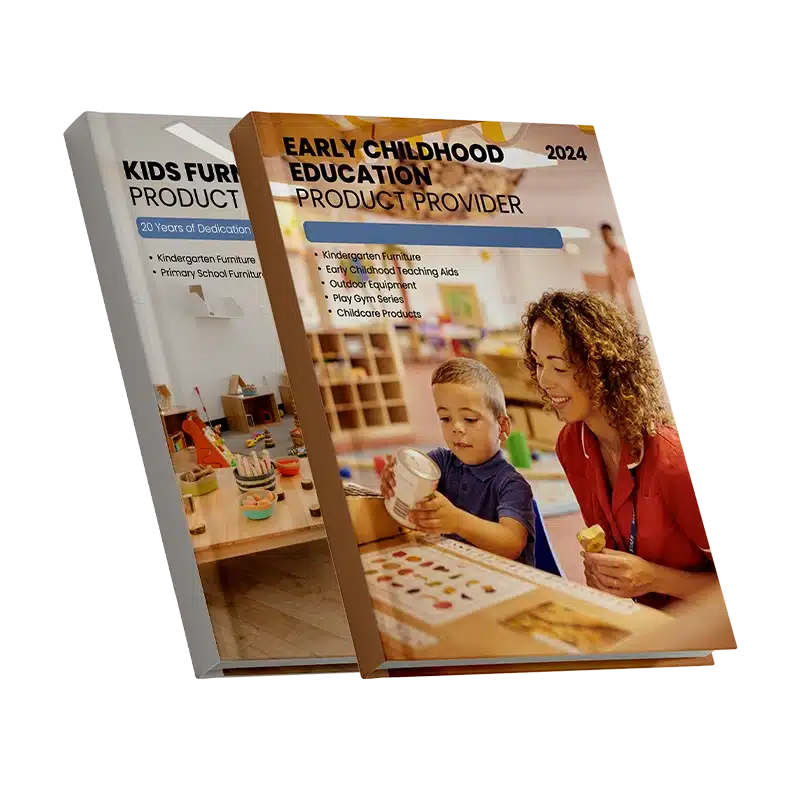
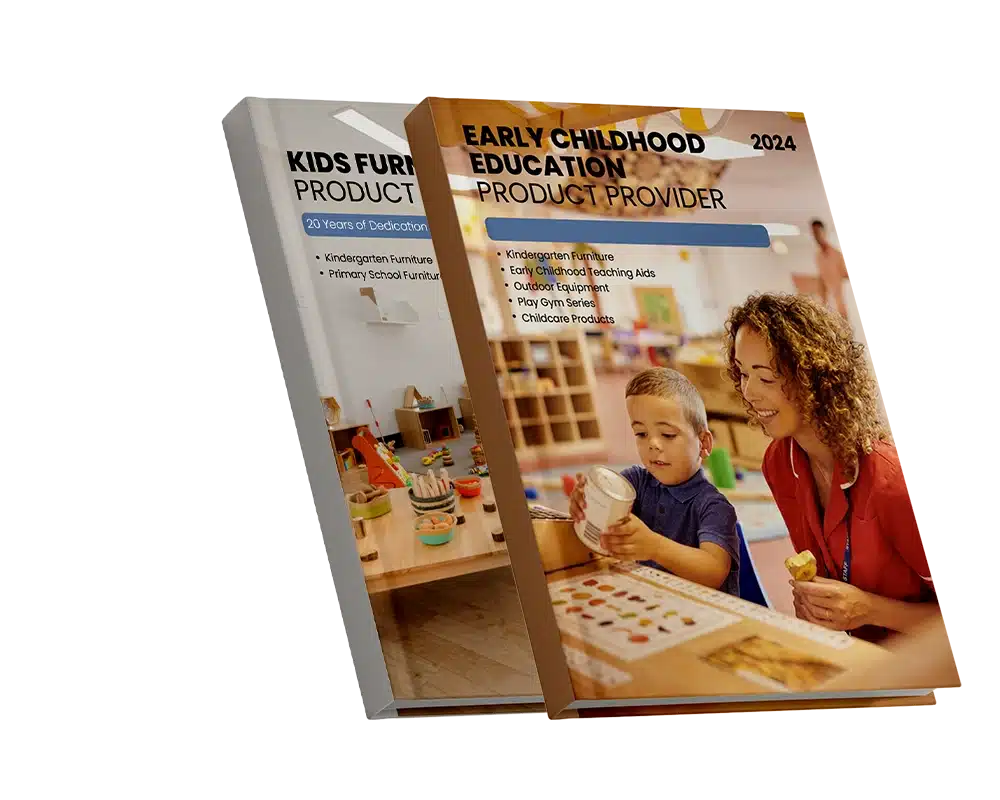
4. Budding Flowers Art
Use tissue paper to create beautiful flower art. Children can tear, crumple, and glue tissue paper onto paper to make colorful flowers, engaging in fine motor skills and creativity.
- Materials: Tissue paper, glue, paper.
- Setup: Provide sheets of paper and various colors of tissue paper for children to create their floral masterpieces.
5. Mud Kitchen
Set up an outdoor mud kitchen where children mix dirt, water, and natural materials to create “meals.” This messy play encourages imaginative role-play and sensory exploration.
- Materials: Water, dirt, pots, pans, utensils.
- Setup: Designate an outdoor area with mixing containers and provide cooking tools in the mud.
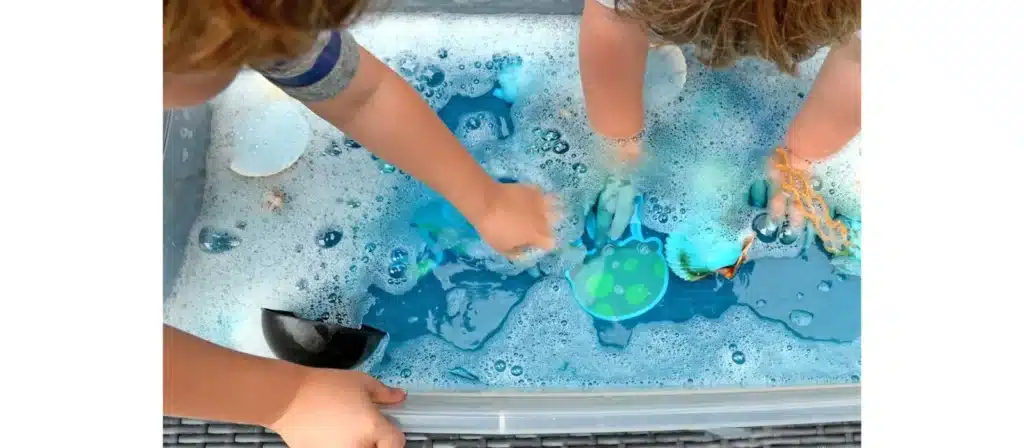
Summer Sensory Activities for Preschoolers
6. Beach Sensory Bin
Fill a bin with sand, shells, and water to create a beach-like experience. Children can dig, build sandcastles, and explore textures, enhancing their tactile and imaginative play.
- Materials: Sand, shells, water, small buckets.
- Setup: Prepare the bin with sand and shells, and add water for extra sensory engagement.
7. Ice Cream Play Dough
Make play dough that smells like ice cream, using scents like vanilla or chocolate. Children can mold and create their favorite ice cream shapes, combining sensory play with imaginative creation.
- Materials: Flour, salt, cream of tartar, scented oils.
- Setup: Mix the ingredients to create play dough, adding scents and colors to resemble ice cream.
8. Water Balloon Play
Fill balloons with water for an outdoor play session of throwing and splashing. This activity engages children’s senses and promotes physical activity and coordination.
- Materials: Water balloons, water.
- Setup: Fill balloons with water and supervise children as they toss and play with them outdoors.
9. Outdoor Painting
Provide buckets of water and brushes for children to paint on pavement or fences. This simple yet engaging activity encourages creativity and fine motor skills while cooling off in the summer heat.
- Materials: Water, brushes, pavement, or fence.
- Setup: Set up buckets of water and brushes outside, allowing children to express themselves through water painting.
10. Fruit Sensory Bin
Fill a bin with real or plastic fruits for children to explore. They can smell, touch, and sort the fruits, promoting sensory awareness and language development.
- Materials: Various fruits (or plastic alternatives), containers.
- Setup: Create a bin filled with assorted fruits, encouraging children to explore and identify each.
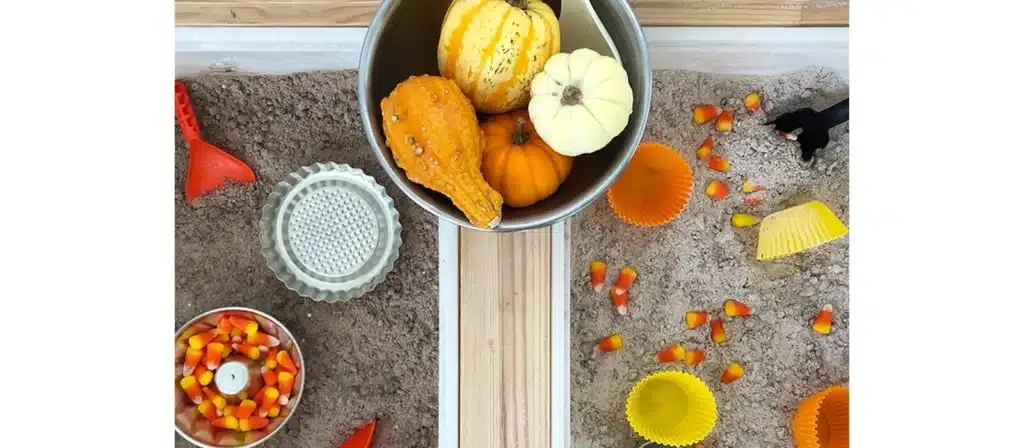
Fall Sensory Activities for Preschoolers
11. Pumpkin Exploration
Set up a pumpkin station where children can touch and explore various pumpkins. Discussing the differences in size, color, and texture fosters sensory awareness and descriptive language skills.
- Materials: Various sizes of pumpkins.
- Setup: Arrange a selection of pumpkins for children to touch, feel, and compare.
12. Leaf Collage
After a nature walk, provide children with collected leaves to create a collage. This activity promotes creativity while exploring different textures and colors found in nature.
- Materials: Leaves, glue, paper.
- Setup: Provide glue and paper for children to arrange and paste their leaves into a beautiful collage.
13. Apple Tasting
Host an apple-tasting session where children can sample different apple varieties. This sensory activity engages taste and encourages discussions about flavor and texture.
- Materials: Various types of apples, plates, knives for slicing.
- Setup: Slice apples and present them on plates for children to taste and compare.
14. Harvest Sensory Bin
Create a sensory bin filled with corn kernels, mini pumpkins, and hay. This activity allows children to explore the textures of fall harvest items while engaging in imaginative play.
- Materials: Corn kernels, mini pumpkins, hay.
- Setup: Fill a large bin with corn, pumpkins, and hay for a tactile sensory experience.
15. Acorn Hunt
Organize a scavenger hunt where children search for hidden acorns. This activity promotes outdoor exploration and teaches children about nature and the changing seasons.
- Materials: Acorns, bags for collecting.
- Setup: Hide acorns in a designated outdoor area and provide bags for children to collect their finds.
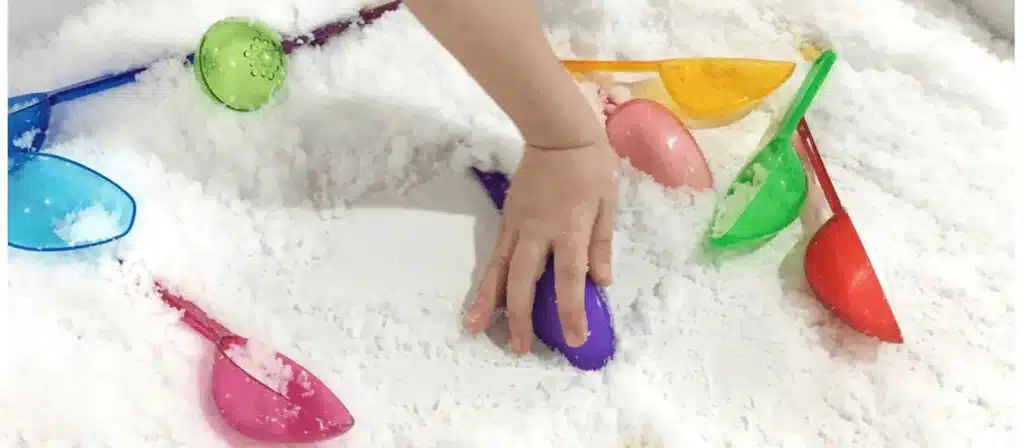
Winter Sensory Activities for Preschoolers
16. Snow Sensory Bin
Create a snow sensory bin using artificial snow and winter-themed toys. Children can scoop, pour, and build, enhancing their tactile experiences in a winter-themed setting.
- Materials: Artificial snow, winter-themed toys, and containers.
- Setup: Fill a bin with artificial snow and add toys for exploration.
17. Ice Exploration
Freeze toys in ice cubes and let children explore to discover what’s inside. This hands-on activity promotes patience as they melt the ice and enhances their fine motor skills.
- Materials: Water, containers, small toys.
- Setup: Place toys in containers filled with water and freeze. Provide tools for children to melt the ice.
18. Winter Wonderland Craft
Using cotton balls, children can create winter scenes on paper. This craft enhances fine motor skills while allowing for creativity and expression.
- Materials: Cotton balls, paper, glue, and markers.
- Setup: Provide materials for children to glue cotton balls onto paper to represent snow and create winter scenes.
19. Scented Pinecones
Use pinecones and essential oils for sensory exploration. Children can smell and explore the textures of the pinecones while learning about different scents.
- Materials: Pinecones, essential oils.
- Setup: Allow children to smell various essential oils on pinecones and discuss their scents.
20. Hot Cocoa Sensory Play
Create a sensory bin with cocoa powder, cups, and scoops. Children can mix and play with the cocoa, engaging in imaginative play while exploring texture and smell.
- Materials: Cocoa powder, containers, cups, scoops.
- Setup: Fill a bin with cocoa powder and provide cups and scoops for children to explore.
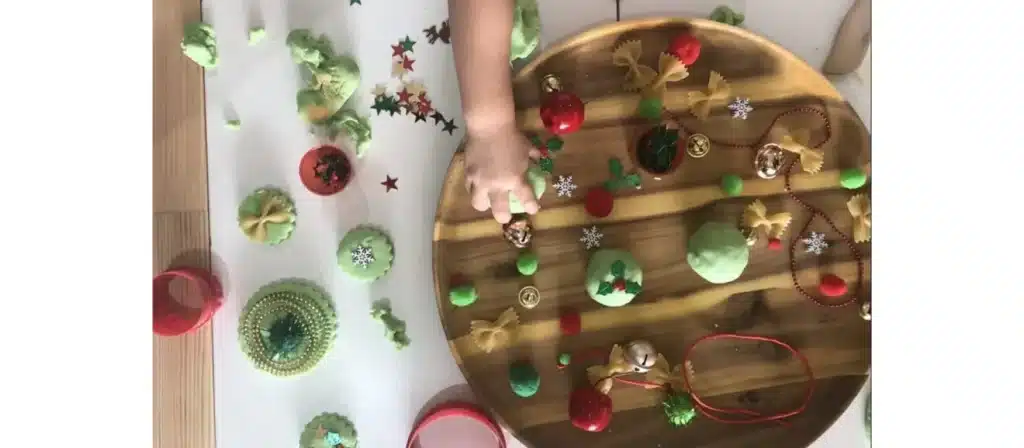
Christmas Sensory Activities for Preschoolers
21. Christmas Tree Sensory Bin
Create a sensory bin filled with fake snow, ornaments, and mini trees. Children can decorate mini Christmas trees, promoting fine motor skills and creativity.
- Materials: Fake snow, small ornaments, mini Christmas trees.
- Setup: Fill a bin with fake snow and provide ornaments and trees for children to decorate.
22. Gingerbread Play Dough
Make gingerbread-scented play dough for children to mold and shape. This activity combines scent and tactile exploration, allowing children to create gingerbread men.
- Materials: Flour, salt, cream of tartar, gingerbread scent.
- Setup: Prepare gingerbread-scented play dough and provide cookie cutters for shaping.
23. Christmas Light Exploration
Set up a station with different colored Christmas lights for children to explore. Discuss colors and patterns while enhancing their visual sensory skills.
- Materials: String lights in various colors.
- Setup: Arrange the lights so children can safely explore their colors and patterns.
24. Christmas Sensory Bottles
Create sensory bottles filled with glitter, water, and tiny Christmas-themed objects like mini ornaments and snowflakes. Children can shake and watch the festive glitter swirl around, stimulating visual engagement.
- Materials: Empty plastic bottles, glitter, water, small Christmas ornaments or charms.
- Setup: Fill bottles with water, glitter, and charms, ensuring they are securely closed for safe play.
25. Snowman Craft
Use cotton balls to create snowmen on paper. This craft enhances fine motor skills and creativity while celebrating the winter season.
- Materials: Cotton balls, paper, glue, and markers.
- Setup: Provide materials for children to glue cotton balls onto paper and create their snowman art.
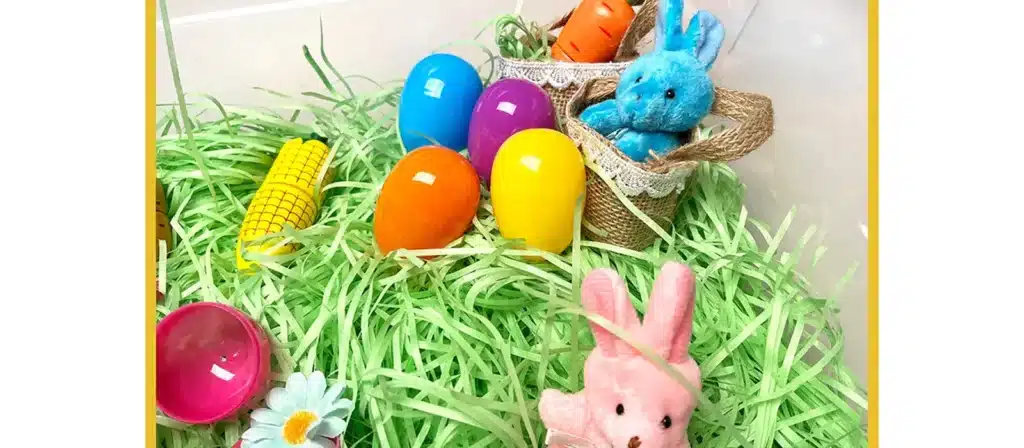
Easter Sensory Activities for Preschoolers
26. Easter Egg Hunt
Organize an Easter egg hunt with plastic eggs filled with sensory items like rice or beans. Children can explore the different sounds and weights of each egg.
- Materials: Plastic eggs, rice, beans, and baskets for collecting.
- Setup: Hide eggs around an area for children to find and explore.
27. Bunny Play Dough
Create bunny-shaped play dough and add scents like carrot and lavender. This sensory activity combines tactile exploration with scent for a fun experience.
- Materials: Flour, salt, carrot scent, cookie cutters.
- Setup: Prepare play dough in bunny shapes and provide scents and cutters for children.
28. Easter Carrot Garden Sensory Bin
Use a bin filled with brown rice or soil and add plastic carrots for a pretend-play “garden.” Children can pretend to plant and harvest the carrots, enhancing their tactile senses and imagination.
- Materials: Brown rice or soil, plastic carrots, small shovels.
- Setup: Fill a bin with rice or soil, adding carrots and shovels for planting and harvesting.
29. Dyed Pasta Easter Egg Sort
Use dyed pasta in pastel colors to represent Easter eggs in a sorting activity. Children can practice sorting by color or size, reinforcing cognitive skills and color recognition.
- Materials: Dyed pasta in pastel colors, small bowls or cups, scoops or tongs.
- Setup: Dye the pasta ahead of time in pastel shades, and provide containers for sorting by color or shape.
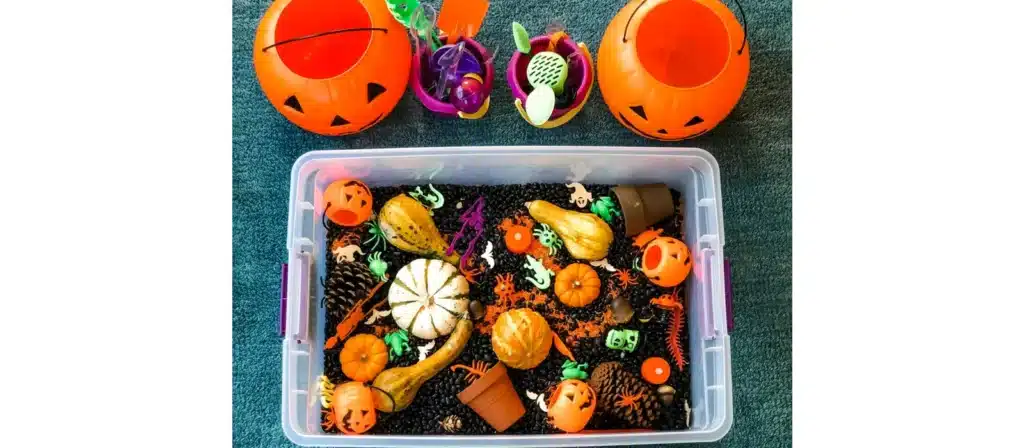
Halloween Sensory Activities for Preschoolers
30. Spooky Sensory Bin
Create a Halloween-themed sensory bin filled with black rice, plastic spiders, and mini pumpkins. Children can dig and explore the materials, enhancing their tactile senses and imaginative play.
- Materials: Black rice, plastic spiders, mini pumpkins, containers.
- Setup: Fill a bin with black rice and mix in the spiders and pumpkins for children to discover.
31. Witch’s Brew
Set up a “witch’s brew” station with sensory ingredients like colored water, herbs, and glitter. Children can mix and pour, enhancing their sensory exploration while engaging in imaginative play.
- Materials: Colored water, herbs, glitter, cauldrons or bowls.
- Setup: Provide containers filled with the ingredients for children to mix their magical brews.
32. Pumpkin Painting
Provide small pumpkins and various colors of paint for children to decorate. This activity combines sensory exploration with creativity, allowing them to explore different textures and colors.
- Materials: Small pumpkins, paint, and paintbrushes.
- Setup: Set up a painting station with pumpkins and paint for children to express their creativity.
33. Monster Feet Sensory Walk
Create a sensory walk using materials like foam, sand, and water. Children can walk barefoot over these textures while pretending they are monster feet, engaging their tactile senses.
- Materials: Foam mats, sand, shallow water bins.
- Setup: Arrange different textured paths for children to walk across, encouraging exploration.
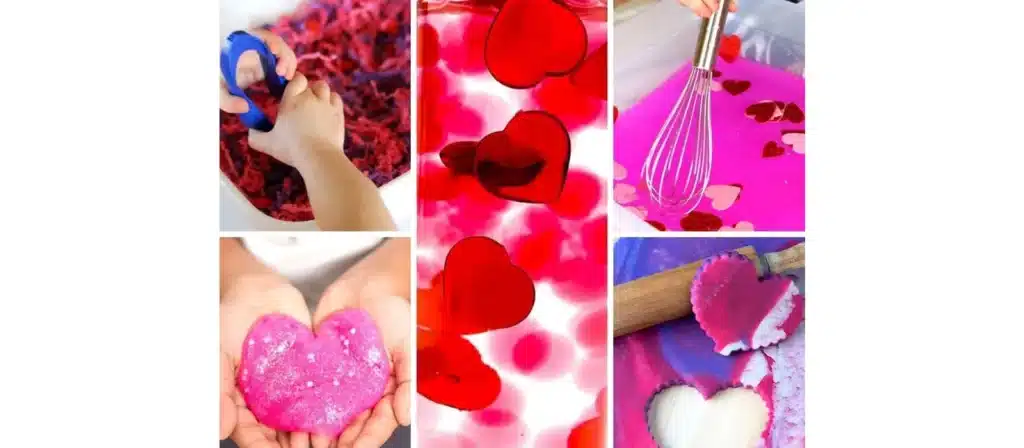
Valentine’s Day Sensory Activities for Preschoolers
34. Love Potion Sensory Bin
Create a sensory bin filled with water, heart-shaped confetti, and scented oils like rose or vanilla. Children can scoop, pour, and explore the materials while discussing love and friendship.
- Materials: Water, heart-shaped confetti, scented oils, containers.
- Setup: Fill a bin with water, and add confetti and scented oils for a fragrant sensory experience.
35. Heart-Shaped Play Dough
Make red or pink play dough and provide heart-shaped cookie cutters and other tools for children to mold and create. This activity encourages fine motor skills and creativity while engaging their senses.
- Materials: Flour, salt, cream of tartar, food coloring.
- Setup: Prepare play dough in heart colors and provide cookie cutters for shaping.
36. Scented Valentine Cards
Allow children to create Valentine’s cards using scented markers or stamps. This activity combines creativity with sensory exploration, enhancing their fine motor skills while discussing the meanings of friendship and love.
- Materials: Cardstock, scented markers or stamps.
- Setup: Provide materials for children to create their scented Valentine cards.
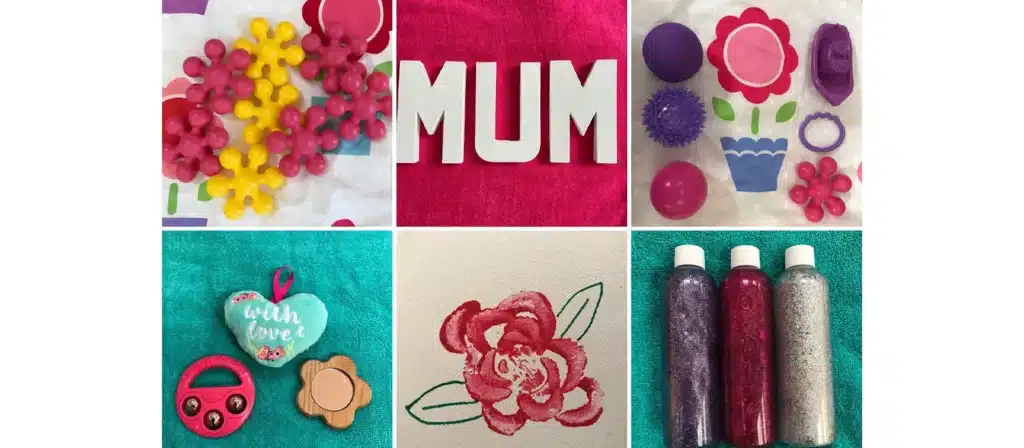
Mother’s Day Sensory Activities for Preschoolers
37. Flower Garden Sensory Art
Provide tissue paper and glue for children to create flower art on paper. This activity allows children to explore textures and colors while making a special gift for their mothers.
- Materials: Tissue paper, glue, paper.
- Setup: Set up an art station with tissue paper and glue for children to create flower designs.
38. Scented Mother’s Day Gifts
Create homemade scented sachets using lavender or other fragrant materials. Children can fill small bags with the scent and decorate them as gifts for their mothers.
- Materials: Small fabric bags, dried lavender, and decorations (like ribbons).
- Setup: Provide materials for children to fill bags with lavender and decorate them as gifts.
39. Mother’s Day Card Making
Allow children to create cards for their mothers using craft supplies like stickers, markers, and glitter. This activity promotes creativity and gives children a way to express their love.
- Materials: Cardstock, stickers, markers, glitter, glue.
- Setup: Provide craft materials for children to design their personalized Mother’s Day cards.
These activities engage preschoolers’ senses while fostering creativity and imagination, making holidays more special through play. Enjoy exploring these ideas!
How to Promote Sensory Play in the Classroom
To promote sensory play activities for preschoolers in the classroom, create designated sensory areas equipped with various materials. Ensure activities are accessible and that children are encouraged to explore freely. Incorporate sensory activities for preschoolers’ lesson plans that link to learning objectives. Collaborate with parents to provide sensory activities for preschoolers at home, reinforcing the importance of play in development.
How to Incorporate Sensory Activities for Preschoolers into Everyday Life
Incorporate sensory activities for preschoolers into daily routines by encouraging exploration during meal prep, bath time, and outdoor play. Use everyday materials like rice, beans, and water to create easy sensory activities for preschoolers. Encourage children to describe their experiences, fostering language development and engagement.
Safety Considerations for Sensory Play
Always supervise sensory activities for preschoolers, especially with small materials that may pose choking hazards. Ensure all materials are non-toxic and age-appropriate. Be mindful of allergies, especially with food-related activities. Create a clean and safe environment to encourage exploration while minimizing risks.
Conclusion
Incorporating sensory activities for preschoolers into playtime fosters crucial development across various domains. Providing engaging and enriching sensory activities for preschoolers, caregivers, and educators can promote growth, creativity, and learning. Explore these activities to create a stimulating environment for your little ones!

